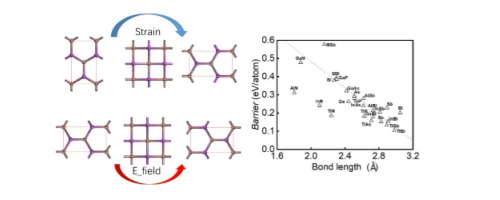Science Bulletin ( IF 18.9 ) Pub Date : 2019-11-06 , DOI: 10.1016/j.scib.2019.11.003 Zhengyuan Tu 1 , Menghao Wu 1

|
We propose a possible ferroelastic switching pathway of two-dimensional (2D) honeycomb lattice (including graphene, BN, stanene, etc.) that may swap its armchair and zigzag direction, reversing an unprecedented strain of 73.2%. Our ab initio calculations reveal that such pathway cannot work in covalent systems like graphene and BN; for monolayer with metallic bonds like stanene, stanane and InBi that have all been synthesized, however, such pathway can be feasible with a low switching barrier (<0.15 eV) and stress (<graphene upon 1% tensile strain), also with the highest energy/stress point in the elastic region. Their distinct behaviors are attributed to the different feature of covalent bonds and metallic bonds: the former is rigid with directionality, while the latter is malleable with ductility. A general trend of linear decrease in switching barrier with uprising metallicity for the same group compounds is revealed. Similar behaviors can be extended to bulk zinc-blended or wurtzite structure that can be deemed as multilayer stacking of buckled monolayer. Binary compounds like InBi monolayer are even multiferroics with both in-plane and vertical ferroelectricity as well as nontrivial topological properties.
中文翻译:

二维蜂窝单层中的超高应变铁弹性:从共价键到金属键
我们提出了一种可能的二维 (2D) 蜂窝晶格(包括石墨烯、BN、锡烯等)的铁弹性转换路径,可以交换其扶手椅和锯齿形方向,逆转前所未有的 73.2% 应变。我们的从头开始计算表明,这种途径不能在石墨烯和 BN 等共价体系中发挥作用;对于已经合成的具有金属键的单分子层,如锡烯、锡烷和 InBi,这种途径在低转换势垒(<0.15 eV)和应力(<1% 拉伸应变下的石墨烯)下是可行的,同时具有最高的弹性区域的能量/应力点。它们的不同行为归因于共价键和金属键的不同特征:前者具有方向性刚性,而后者具有延展性。揭示了同一组化合物的转换势垒随着金属丰度的上升而线性下降的一般趋势。类似的行为可以扩展到块状锌混合或纤锌矿结构,可以将其视为弯曲单层的多层堆叠。


























 京公网安备 11010802027423号
京公网安备 11010802027423号